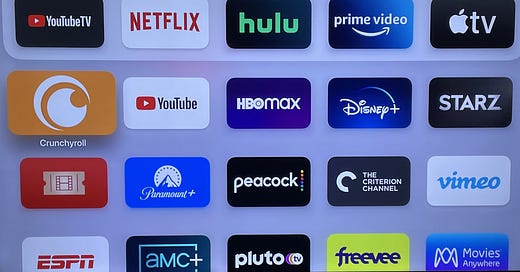I last did something like this here in February.
“Our TV base is YouTubeTV. $65 a month/$780 year.
We pay, via YouTubeTV for a pay-tv package of HBO/Showtime/Starz. $30 a month/$360 a year. A la carte, it’s $15 for HBO/HBO Max, $11 for Showtime, $9 for Starz.
The total package costs $1140 a year or $95 a month.”
In the 7 months since, everything except for the base price of YouTubeTV has changed. And changes, it seems, every few months, with new offers, as streamers chase new subs.
This is what my TV currently looks like via AppleTV. By design, the AppleTV syncs itself on all of the TVS in our home. The hierarchy is a fairly accurate representation of how thing are prioritized.
YouTubeTV is the anchor. $65 a month. It is how we watch local TV stations (though we do have antennas that pick up local digital broadcasts on all of our TVS), cable news, sports, and a few cable networks we frequent.
I have stuck with YouTubeTV (a Google product) over Hulu Live TV because Hulu Live TV has no PBS…
Keep reading with a 7-day free trial
Subscribe to The Hot Button by David Poland to keep reading this post and get 7 days of free access to the full post archives.




